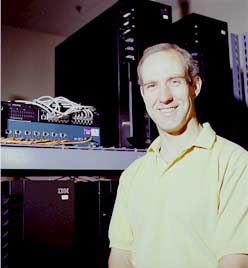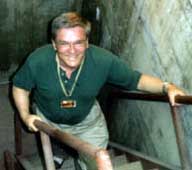| A mining pollution solution
Scientists at DOE's Los Alamos National Laboratory have developed a technology capable of removing toxic metal contaminants from acidic mine runoff. The technology, known as Polymer Filtration, uses patented water-soluble, ion-binding polymers to remove contaminants like lead from acid mine drainage, while allowing for recovery of valuable metals like silver, copper and zinc. These metals are typically lost in conventional remediation processes. The technology provides a potential remedy for environmental problems arising from the thousands of abandoned mine sites in the United States that pose hazards to local aquifers.
Armor through atomization
The DOE's Idaho National Engineering and Environmental Laboratory is working to make armored vehicles of the future lighter and more maneuverable. Using an atomization process and optimizing the composition, researchers are creating composite steel alloy powders that exhibit extreme hardness, without requiring additional heat treatment. In the atomization process, the cooling rate is controlled to maintain the composite properties of the alloy within nano-scale crystals. Researchers plan to use the powders to create thinner armor that also has superior ballistic performance. The spray atomization process facilitates the creation of complex shapes, a major advantage over current armoring methods, and can facilitate one-step production of armor coatings.
Fast bio-identification in the field
Researchers from DOE's Lawrence Livermore National Laboratory have developed a portable instrument for rapidly identifying microbes from biological weapons or infectious disease outbreaks. Called ANAA, for Advanced Nucleic Acid Analyzer, the battery-operated system provides critical information about biological agents in minutes rather than the more conventional hours or days. "This instrument can also be used in settings such as a hospital emergency room, where rapid analysis of samples is needed," said Ray Mariella Jr., director of LLNL's Center for Microtechnology. A detailed article on the instrument and its capabilities was published in the April 16 issue of Science magazine.
Permanent magnet accelerator technology saves energy
Permanent magnets require no power or cooling water to operate-like the magnets that stick to your refrigerator door. They have played a significant and award-winning role in the seven-year, $259-million Main Injector Project, recently completed on time and within budget at the DOE's Fermilab (http://www.fnal.gov). The Federal Interagency Energy Policy Committee and the Department of Energy presented a Federal Energy and Water Management Award to Fermilab. And physicists Bill Foster and Gerry Jackson were named Fellows of the American Physical Society for their work in designing the new Antiproton Recycler Ring, the world's largest use of permanent magnets.
PROSPECT for predicting protein shapes
What a protein does depends on its shape-information that is vital to developing new drugs. Although the amino-acid sequences of tens of thousands of proteins have been determined, the three-dimensional structures of only about 1500 different proteins are known. Because determining protein structures experimentally is time consuming and tedious, scientists are using computer modeling to predict protein structure quickly from amino-acid sequences. In a recent international contest involving about 100 groups, DOE's Oak Ridge National Laboratory computer package, called the Protein Structure Prediction and Evaluation Computer Toolkit (PROSPECT), scored in the top five percent because it can predict accurately an unknown protein's detailed shape and amino acid positions.
Stealth insurance
When a U.S. fighter pilot is flying over enemy territory, he may worry whether or not his stealth fighter can be detected by radar. Researchers at DOE's Pacific Northwest National Laboratory are helping ease the minds of pilots and their ground crews with a hand-held holographic three-dimensional radar camera that can verify the condition of an aircraft's stealth characteristics. The radar camera is helping the U.S. Air Force determine the condition of radar-absorbing material on F-117A Nighthawks, and the technology can be applied to other stealth aircraft as well.
Trees grow faster in CO2-rich 21st century atmosphere
Trees bathed in atmospheric carbon dioxide at levels expected by the year 2050 grew 25 percent faster, according to results from a facility built by DOE's Brookhaven National Laboratory in a North Carolina forest. But the increased growth is not likely to continue, nor to compensate for the effects of CO2 emissions. The report, based on research at the Forest-Atmosphere Carbon Transfer and Storage (FACTS-1) facility, was published by scientists from the University of Illinois, Duke University, Brookhaven and others. FACTS-1 is one of several such Brookhaven facilities around the world used by scientists to evaluate the effects of global change on plants and ecosystems.
|
|
Recipe for a supercomputer
 |
| David Halstead |
As a theoretical chemist, David Halstead quickly discovered that supercomputers were a necessity-not an option.
"You want to make your simulation effective and interesting," says Halstead, an associate scientist in the Scalable Computing Lab at DOE's Ames Laboratory. "You need a big machine. That's where my interest started."
Halstead's abilities are a perfect fit at the SCL, where he and his colleagues search for effective, affordable approaches to parallel computing. They have written a Web-based "cookbook" that explains how to network personal computers to create parallel-computing "clusters." The ingredients-PCs and network switches-can be found on the shelves of most computer stores.
"This really is the way to go if you want to build a low-cost machine," Halstead says, adding that the operating system is free and that DOE develops free message-passing libraries for these systems.
PC clusters fill a valuable niche in today's scientific world. Researchers can use the smaller systems to develop the complex code that will enable them to run simulations in a parallel-computing environment. The code can then be moved onto larger, more powerful machines.
"We give people a way to learn how to do power programming without having to apply for computer time on huge machines before they really need the horsepower," Halstead says.
The SCL examines ways to enhance communication between machines in the clusters, as well as finding methods for developing code that is both portable and scalable. "The lifetime of a computer is maybe two or three years, but the lifetime of scientific code can be decades," he says.
The SCL manages clusters ranging in size from eight to 128 CPUs that are used by researchers from Ames Laboratory and Iowa State University for chemistry, physics, engineering, mathematics and molecular biology problems. "We get a good sanity check from a real-world audience," Halstead notes.
Submitted by DOE's Ames Laboratory |


